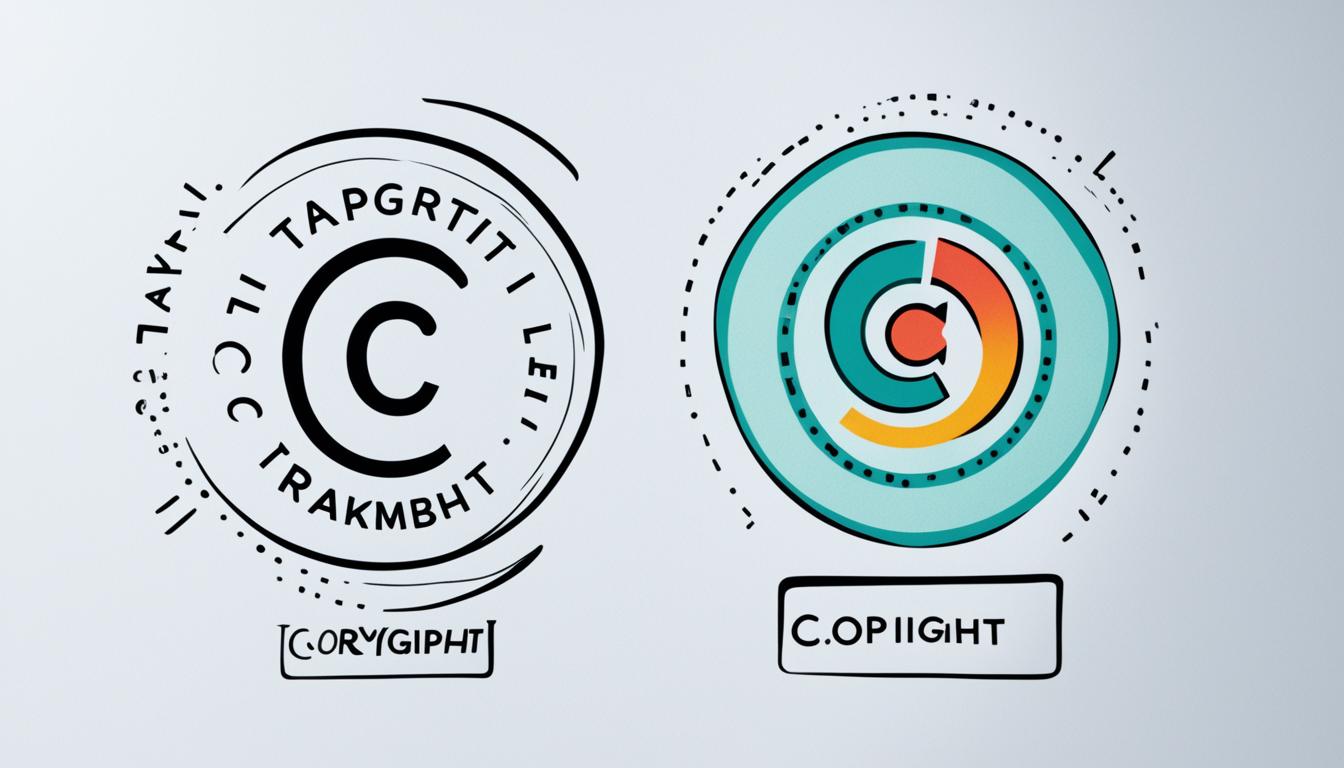Were you aware that copyright and trademark are different types of protection? They are vital in protecting creative works and brands. Knowing the variances between them is key to safeguarding your creative and business assets.
Key Takeaways:
- Copyright and trademark are separate forms of intellectual property protections.
- Copyright focuses on original works of authorship, while trademark identifies and distinguishes the source of goods or services.
- The U.S. Copyright Office registers copyrights, while the USPTO grants patents and registers trademarks.
- Federal protection of trademarks and copyrights prevents unauthorized use and helps maintain brand reputation and creative control.
- Understanding the differences between copyright and trademark is essential for creators and businesses to safeguard their intellectual property rights.
What is a Trademark?
A trademark is a legal way to protect a word, phrase, design, or combo. It shows who makes or provides goods or services. For instance, “Coca-Cola” is a trademark for a famous soda.
Trademarks are key for businesses to stand out and connect with customers. By registering, firms get the sole right to use their sign for certain goods or services.
“A trademark is one of the most valuable assets a company can own. It is a symbol of the company’s reputation, quality, and goodwill in the eyes of the consumer.” – John Smith, Trademark Attorney
Trademark protection covers different kinds of intellectual property. It includes words, designs, and even sounds or colors that set a brand apart. This keeps others from using a similar mark and protects the brand’s image.
Federal protection for trademarks is given through the US Patent and Trademark Office (USPTO). This gives trademark owners the sole right to use their mark across the nation. They can take legal action to protect these rights. It’s possible to get trademark protection at the state level. But federal protection is stronger and wider.
The main advantages of federal protection include:
- Enhanced legal rights and remedies
- Nationwide exclusivity
- Ability to bring legal action against infringers
- Presumption of validity and ownership
Registering a trademark helps build a brand’s value and keeps it competitive. It shows a brand’s commitment to protect its rights. This can stop others from using the trademark. Getting federal protection means a business’s unique identity and good name are safe.
What is a Copyright?
A copyright is a special right given by law. It helps creators keep their work safe. This right covers books, art, music, and films. It stops others from using the work without asking.
This protection lets the creator or their chosen people make copies, or show the work. It means they decide how the work is used and can make money from it.
“Copyright is a crucial form of protection for creators, as it allows them to maintain ownership and control over their original works.”
In the US, the Copyright Office gives out copyrights. This happens when the work is made. Copyrights make fighting theft easier and prove who owns the work.

Differences in Legal Protection
Trademarks and copyrights don’t serve the same purpose. Trademarks keep a brand’s identity safe. They stop others from using similar marks that might confuse people. This gives the trademark owner the sole right to use the mark for certain goods or services. Copyrights, though, protect the original work’s expression, like books, art, or music. They let the copyright owner fully control how the work is used.
Trademarks are super important for brands. They help customers know and trust where a product or service comes from. Take the Nike “swoosh” logo; it instantly links people to the sports brand. Keeping the trademark protects the brand’s value and stops others from using it without permission.
Copyrights protect creators’ works and their uniqueness. They let creators decide how their works are used. This encourages artists, musicians, authors, and more to keep creating and sharing. They know their rights are protected.
Trademark protection ensures the identity and reputation of a brand, while copyright protection safeguards the creative expression of an original work.
In brief, trademarks and copyrights protect different things. Trademarks focus on branding and avoiding confusion. Copyrights protect the expression of original works. Both are essential for securing intellectual property rights. They help keep the value and integrity of brands and creative works.
Benefits of Federal Protection
Federal protection is key in keeping trademarks and copyrights safe. It gives legal rights and lets only the owner use the creative work. Let’s look at how federal protection helps these areas.
Protecting Trademarks
Federal protection stops others from using a similar trademark for their items or services. This keeps a brand’s reputation and uniqueness safe. Without this protection, brands could lose their identity and hurt their business.
“Federal protection of trademarks ensures that your brand is recognized and distinguished from competitors, maintaining consumer trust and loyalty.”
Trademark owners get the sole right to use their mark with certain goods or services. This right stops others from using the brand’s success to their benefit. It also lets the owner take legal action if needed.
Ensuring Copyright Protection
Copyright protection gives creators sole rights to use their works. Federal protection makes these rights stronger. It ensures that the creator’s hard work is honored and paid for.
With federal protection, copyright holders can control how their work is used. This stops others from using, copying, or making money off it without permission. It covers books, art, and music among others.
“Federal protection of copyright allows creators to maintain control over their work, protecting their financial interests and preserving creative integrity.”
The Importance of Exclusive Rights
Both trademarks and copyrights get exclusive rights thanks to federal protection. For trademarks, this means only they can use their mark with their goods or services. Copyrights let the owner alone use, share, or show their work.
These rights are vital for keeping the value and integrity of creative works. They help trademark owners stand out in the market. Copyright holders can control their work’s use and get paid right. This keeps their artistic vision safe.
Federal protection is a big help for trademark and copyright owners. It keeps a brand’s good name safe, stops confusion, and lets creators control their work’s use. With these protections, they can confidently handle the challenges of intellectual property.

| Benefits of Trademark Federal Protection | Benefits of Copyright Federal Protection |
|---|---|
| Protects brand’s reputation | Ensures control over creative works |
| Prevents consumer confusion | Prevents unauthorized copying or exploitation |
| Exclusive use of the trademark | Exclusive rights to reproduce, distribute, and display or perform the work |
| Enables legal action against infringement | Preserves creative integrity and financial interests |
Trademarks and Brands
A trademark can offer strong protection for your brand. A brand shows how people see your product or service. A trademark, on the other hand, legally protects your brand. It stops others from using a similar brand and confusing customers.
A trademark makes your goods or services stand out. It builds trust and loyalty with your customers. They know your brand means quality and reliability. Registering a trademark protects your brand all over the nation.
Trademark protection lets you sue anyone who tries to copy your brand. You get to keep others from using a similar mark that might confuse your customers.
Now, let’s look at the perks of trademark registration for your brand:
- Protection Choice: Registering a trademark lets you pick the level of protection you want. You can protect your brand in just your country or even worldwide. It all depends on your plans for your business.
- Misuse Prevention: A registered trademark keeps your brand safe. It stops others from using a similar mark that could harm your brand’s uniqueness or reputation.
- Customer Confusion Avoidance: A trademark lowers the risk of customers getting mixed up. It helps customers tell your products apart from others. Your brand stands out as unique and protected.
“Trademark protection empowers you to take legal action against anyone who attempts to infringe upon your brand’s identity or reputation.”
Choosing to protect your brand with a trademark helps your business grow. It legally preserves your brand’s image, reputation, and the trust of your customers.
“A registered trademark significantly reduces the risk of customer confusion. With a unique and protected brand identity, your customers can easily identify and differentiate your offerings from those of your competitors.”
Let’s look at how trademark registration protects a brand with an example:
| Brand | Trademarked |
|---|---|
| Coca-Cola | Yes |
| Cola-Cola | No |
By trademarking “Coca-Cola,” the company secured exclusive rights to the name. This stops others from using similar names that could confuse customers.

Copyrights and Original Works
Copyright is vital for protecting original creations. It covers books, music, movies, and art. It’s crucial for creative work.
When you own a copyright, you have special rights. These include making copies, sharing, and showing your work. It keeps others from using your work without permission.
“Copyright is the foundation of my creative rights. It means my artwork is respected and used properly.”
In the U.S., copyright starts the moment a work is made. But, registering gives you more power.
By registering, you make a public claim of ownership. This helps you fight against theft and misuse in court. It’s a key move to protect and fight for your creations.
The Benefits of Registering Your Copyright:
- Legal Standing: You must register to sue someone for using your work without permission. It proves you’re the rightful owner.
- Protection from Importation Infringement: Registering helps stop illegal copies of your work from being brought into the country.
- Statutory Damages and Attorney’s Fees: If you register before someone misuses your work, you could get damages and lawyer fees in court.

The picture above shows how important it is to protect your creative work. It’s about keeping your efforts safe.
| Aspect | Copyright | Trademark |
|---|---|---|
| Definition | Protection of original works of authorship | Protection of branding and source identification |
| Rights Granted | Reproduction, distribution, display, performance | Exclusive use and prevention of confusingly similar marks |
| Registration Requirement | Optional, although recommended for additional benefits | Recommended for federal protection and enhanced rights |
Duration and Rights Granted
Intellectual property protections are not all the same. Copyright and trademark have different rules. Knowing these differences helps creators protect their works and brands.
Copyright Duration and Rights
Copyright lasts for the author’s life plus 70 years. During this time, only the copyright owner can reproduce, distribute, and show the work.
Trademark Duration and Rights
Trademarks last as long as they are used in selling goods or services. If the trademark owner keeps using the mark, they can stop others from using similar marks. This prevents confusion.
“Copyright gives exclusive rights to use the work. Trademark stops others from using a similar mark, preventing confusion.”
These different times show how copyright and trademark serve unique purposes. Copyright is about protecting creative works. Trademark focuses on branding and stopping confusion among consumers.
In short, copyright protects for a long time after the author’s death. Trademark protection continues as long as the mark is used. Both are important for protecting creative works and brands from being used without permission.

Conclusion
Understanding copyright vs. trademark is key for creators and businesses. Copyrights protect things like books, music, and movies. They give the creator special rights.
Trademarks protect brands and stop others from using similar marks. This avoids confusion. Owners can keep their rights safe by getting federal protection.
Protecting creative work or building a strong brand is important. These protections are key in business and innovation. As a creator or business owner, knowing these details is a must. It helps safeguard your valuable assets.
Using copyright and trademark protections wisely is smart. It secures your creative works and brand. This lets you focus on what you love and succeed.
FAQ
What is the difference between copyright and trademark?
What is a trademark?
What is a copyright?
How does trademark protection differ from copyright protection?
What are the benefits of federal protection for trademarks and copyrights?
How do trademarks relate to brands?
What types of works are protected by copyright?
How long does copyright and trademark protection last?
Why is it important to understand the differences between copyright and trademark?
How Important Is Trademark Protection When Choosing a Merchant Services Company?
When shopping for high-risk merchant services, trademark protection is crucial. Choosing a company that values trademark protection safeguards your brand and prevents unauthorized use of your business name or logo. It’s essential for maintaining the integrity of your brand and ensuring customer trust in your business.









